The image of the Cordovan patio is inherited from the Islamic tradition. It is an open space inside a house that serves to provide lighting and ventilation to the rooms that surround it. Initially, arose in Mesopotamia, around the year 3200 a.C., and it was the Greco-Roman culture that gave this architectural element a greater relevance in the distribution of houses. It was an open-air room with a peristyle, that is to say, with a gallery supported by a series of regularly spaced columns. In them, daily and family life was developed and visitors were received: it was revealed as an important place of coexistence.
With the irruption of the Arabs in the Peninsula, innovations were introduced. Home decoration was oriented towards the interior: the facades were simplified and, instead, patios were embellished with tiles, latticework and brick or cobblestone floors. What's more, highlighted the importance of water and the proliferation of sources, fountains and ditches, which led to the development of floral ornamentation, fruity and arboreal.
In later centuries, important elements would be introduced, like flowerpots, archaeological elements or gates - replacing the old wooden gates -, giving rise to a very characteristic eclectic architecture that lasted until the 20th century, time in which the tenement houses arose: unoccupied palaces that were remodeled to be inhabited by population from rural areas. In these houses the patio would be constituted as the meeting place of its inhabitants, since it would be the place of the kitchens, common toilets and laundry rooms.
The city of Córdoba is one of the greatest exponents of this historical evolution, that has ended up forming beautiful images in which water merge in its patios, light and greenery. Each patio presents a unique architecture, so it is difficult to classify them, but roughly they are usually included in two types, the monumental ones - old palaces of the aristocracy or religious buildings - and the courtyards.
Following, we are going to draw a tour through the streets of the ancient Caliphal capital to visit and relive the beautiful history of these remote spaces capable of taking your breath away.
First, emphasize that the visit to the Patios de Córdoba is free and free. Any person or group that wishes can walk around the city and visit them from the 6 al 19 of May, both included, on schedule 11:00 a 14:00 h and from 18:00 a 22:00 hours.
- Alcázar Viejo Route
- Jewish Route
- San Santiago Route – Saint Peter
- Regina Realejo Route
- Santa Marina Route – San Agustin
- San Lorenzo Route
Alcázar Viejo Route (1)
Duartas, 2: old tenement house that in the 90 became single family. Inside we find a rectangular patio that presents, on one side, a gallery. Patio decor features an antique laundry room, various wooden cages with canaries and goldfinches, as well as a great variety of beautiful flowers and plants.
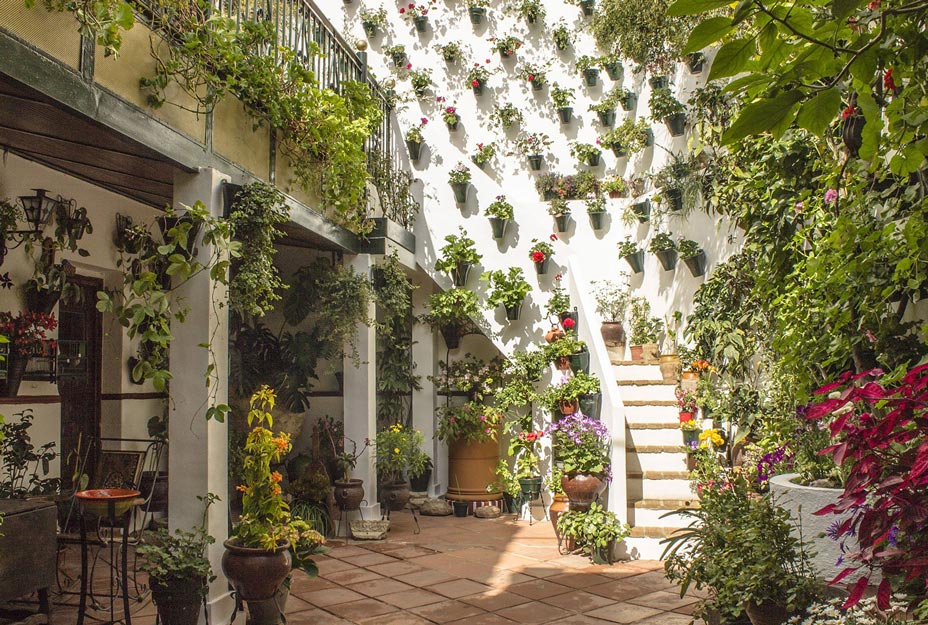
Postrera, 28: house dating from the 16th century and retaining much of its original appearance. To the right of the patio the rooms open, and on the left side we see the laundry sink, the well and a staircase of ancient steps.
San Basilio, 44: this old tenement house maintains the original architectural style. The patio has three of its four sides arcaded with whitewashed stone pillars, a protruding staircase located in the center of the front wall, Cordovan soil and a well with a work curb.
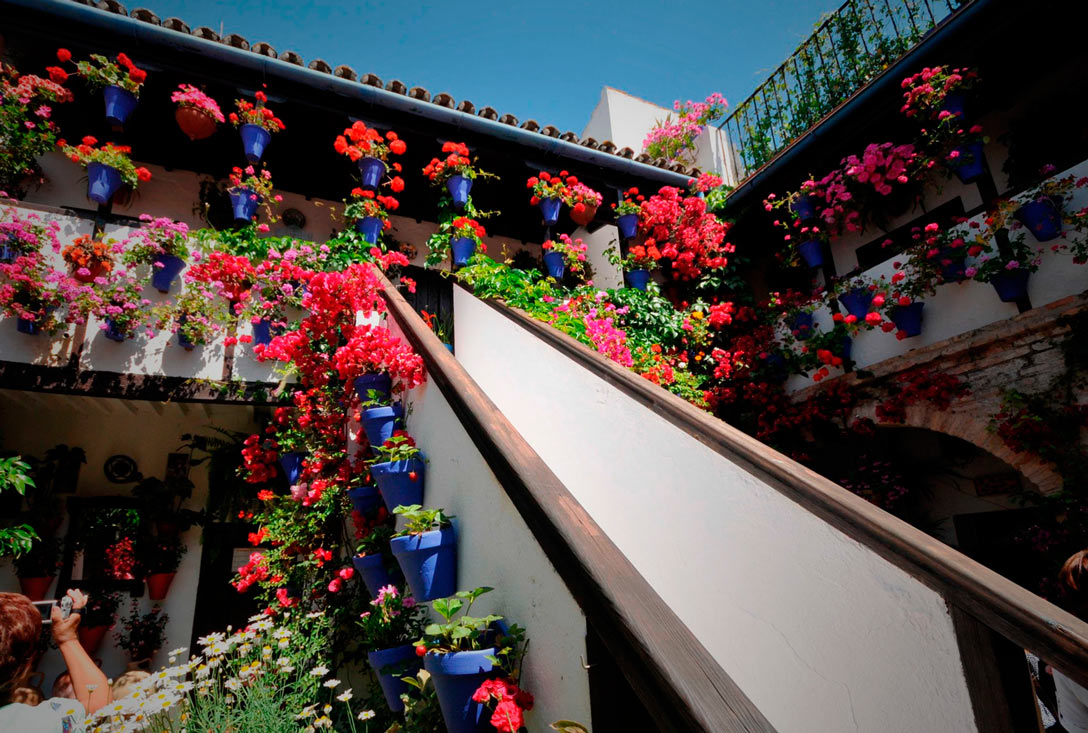
San Basilio, 22: the patio of this old tenement house has a portico in which there is a staircase that goes up to the upper gallery. The patio is paved with Cordovan Chinese, where two heraldic shields are drawn. A pylon covered with tiles and two false semi-circular arches stand out..
San Basilio, 20: small patio that owns, next to its beautiful plants and flowers, large amount of archaeological remains: capitals, stone bases and shafts from Roman and Arab times.
San Basilio, 15: patio with archaeological remains and ironwork from an old tavern that was located on the site on which this house was built.
San Basilio, 14: Baroque style house that currently presents other architectural styles, with three semicircular arches on two limestone stone columns, communal kitchen and a laundry room with two old sinks.
Martin de Roa, 7: of this patio stands out its wooden gallery and its roofs at different levels. What's more, features one of the best outdoor pit and laundry sets.

Martin de Roa, 9: elements of the Muslim era persist in this courtyard, like a door with a big lock and knocker. Above the main entrance there is a gallery of beams with a wooden railing, supported on two exposed brick pillars.
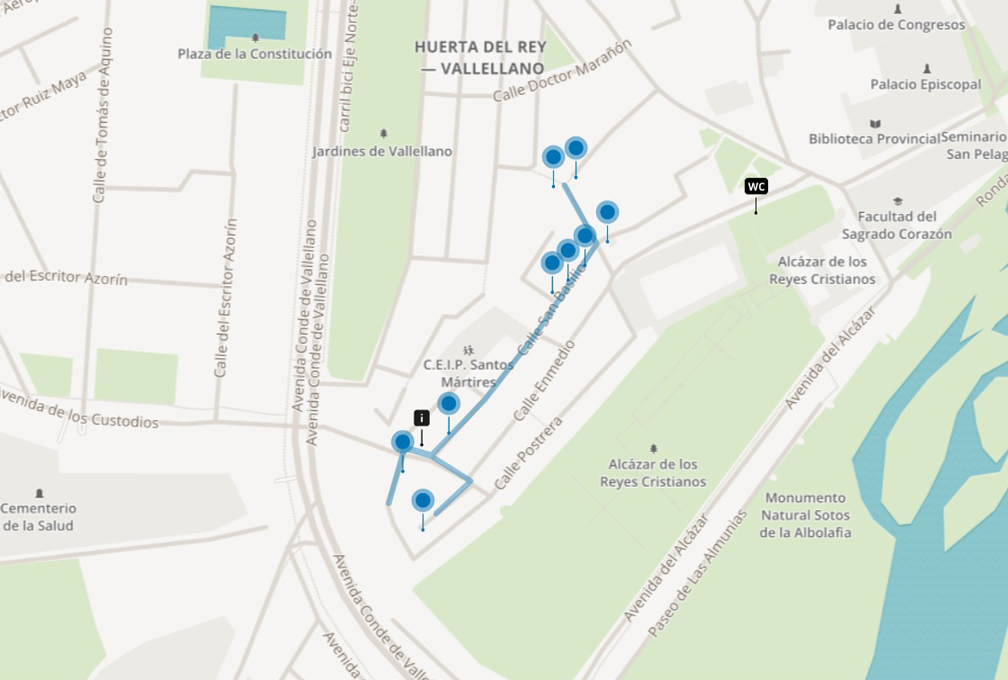
Jewish Route (2)
Ramón y Cajal Square, s/n: headquarters of the Subdelegation of Defense of Córdoba and former palace of the Venegas de Henestrosa. The building has several patios, Among which stands out the one located right at its entrance. The structure of this patio revolves around a central octagonal fountain tiled with tiles and four garden areas.
Jews, 6: housing of more than 300 years old that was a candle factory and a Carmelite hospital. It has a quadrangular patio with clay slabs, half-height tiled walls and central fountain in the shape of a five-pointed star.
Artisan souk: quadrangular plan patio, whitewashed walls and cordovan wood flooring. It has four arcaded galleries. Its ornamentation is simple and traditional, highlights a well, a rectangular font, ancient columns and archaeological pieces.
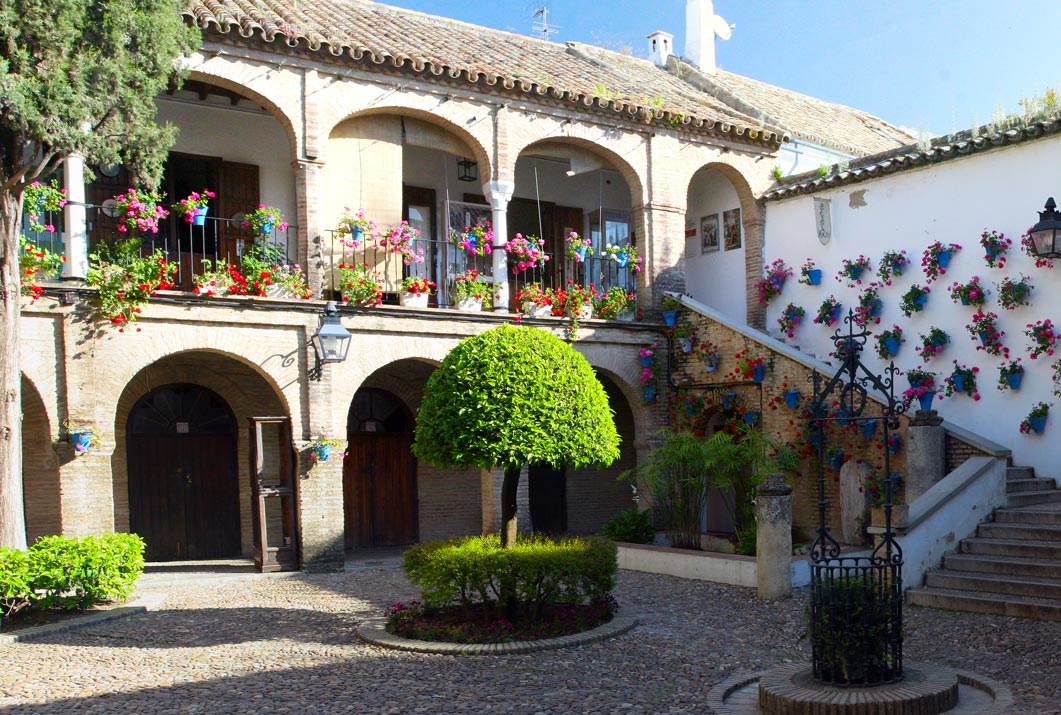
Lawns, 10: house of more than 100 years old with a square-framed patio. Two arched porticoes of different sizes with exposed brick and columns face each other in the courtyard. The floor is checkered, a stone fountain and a basin decorated with tiles stand out.
Samuel de los Santos Gener, 9: in this building we find three patios. In the first one there is a Mudejar style portico with three semicircular arches, a side bed and a trough. In the center of the second courtyard there is an old wash basin and a mill wheel. The third courtyard has two facing porticoes, with a beautiful Mudejar hexagonal fountain in the center and a well with an iron curb.
Samuel de los Santos Gener, 5: its portico stands out from this patio, whose structure of semicircular exposed brick arches and columns topped by Tuscan capitals are repeated on the lower floor on three of its sides. The courtyard ornament, apart from their pots and plants, features various antique furniture and metal and ceramic vessels.
Martínez Rücker, 1: in this courtyard the well with Arab curb and several wooden doors with wrought iron elements stand out. The pavement is made of Cordovan Chinese. Likewise, this patio features our most traditional ornamental flora.

Potro Square, Fosforito Flamenco Center: it is a central courtyard with a rectangular plan, of whitewashed walls, with its stables and the bowling ground. On the right side of the patio there is an old pylon.
Potro Square, Museum of Fine Arts: here stands the plateresque façade of what was the Hospital de la Caridad. The patio has a beautiful central fountain. At, linked together by corridors of Cordovan Chinese, there are triangular-shaped flowerbeds with orange trees and shade plants.
Potro Square, Patio Garden and Study of Casa Romero de Torres: It is located inside the premises of the current Fine Arts Museums of Córdoba. The backyard, which in its day was an authentic archaeological garden of which there are still obvious signs, It presents in its final part a large room that over time was the Museum's restoration workshop.
Master Luis, 22: this patio has three galleries of lintel porticoes on cast iron columns. The pavement is made of hydraulic slab. Presents some archaeological pieces, like a gothic balustrade and a 17th century column base. In the floral field they stand out, above all, the two large lemon trees in ‘espalier’.
Master Luis, 9: the backyard, square plan, it is composed on three of its sides by wooden windows with stone frames. The pavement is cordovan enchinado in the center, surrounded by red clay tiles. The walls are tiled, Up to the middle, with Sevillian tile. The back wall is dominated by a triumph of Saint Raphael, in tile and stone. Under it the water gushes from a fountain, that falls to different levels, ending in a ditch that leads to a large octagonal brick fountain with a white marble spout that occupies the central part of the patio.
Master Luis, 4: known as Patio de los Ladrillos, It has a trapezoidal plan and consists of a portico of semicircular brick arches with white Caliphal-inspired columns. The walls are made of brick and the floor is paved with white Cordovan Chinese with geometric drawings.. This patio has a large circular fountain with a central fountain and a brick channel around it..
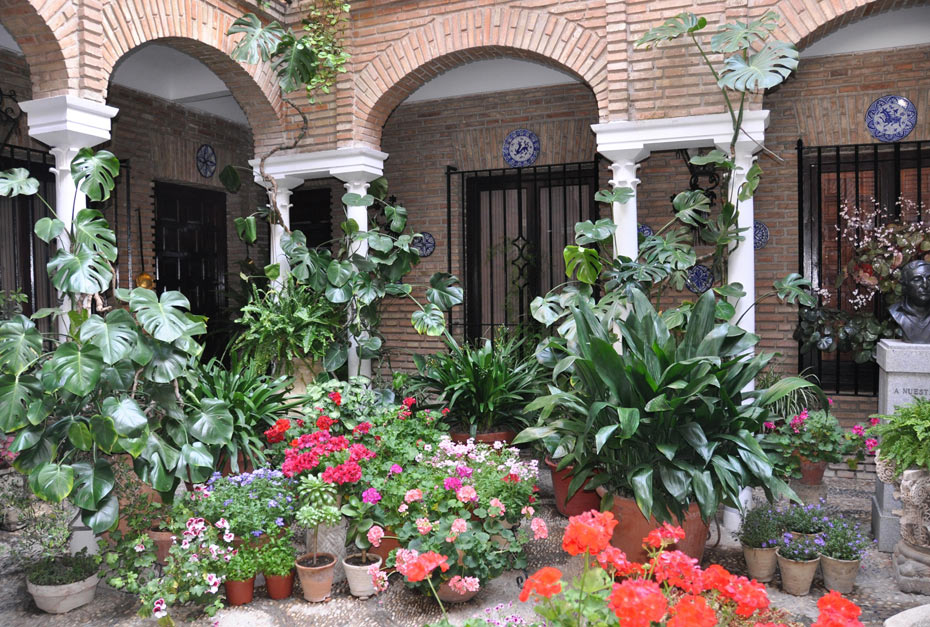
Pompeyos, 6: the patio has a square plan, white walls and cordovan wood flooring. On the south and east sides there are three columns of red Goat marble that support four arches and two balconies with elaborate moldings.. It is worth highlighting the decoration of the intradoses, which are painted in fresco simulating marble voussoirs. Regarding the decoration, highlights the small circular fountain, made of stone, that occupies the center of the patio.
Jerónimo Páez Square, s/n: two main courtyards in the Renaissance building built by Hernán Ruiz. The first access patio has a central pond, floor with checkered pavement of terrazzo and Cordovan Chinese, and has great architectural pieces of the buildings of the Roman city. The second courtyard is surrounded by arcades of marble columns that support banked carpal arches with the same composition on the ground and upper floors., with four galleries covered by a wooden coffered ceiling and a central fountain formed by an octagonal font decorated with tiles and a cement bowl with a spout. Here mosaics are exhibited in the galleries, and various archaeological pieces from the city of Córdoba.
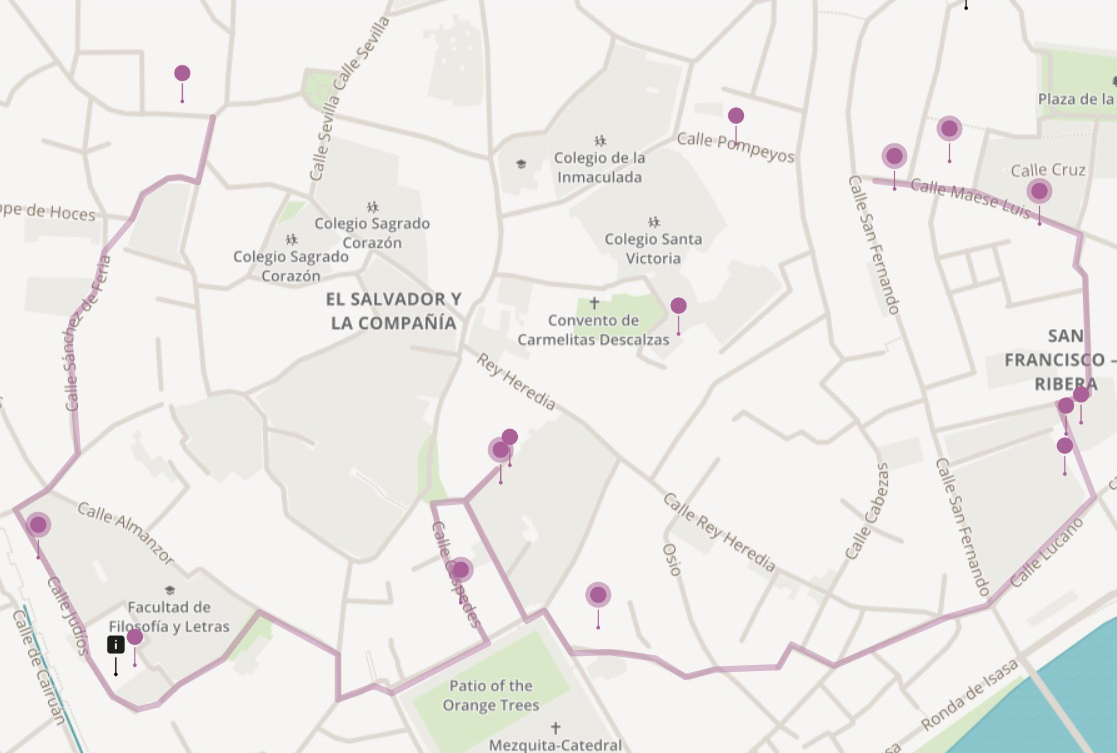
San Santiago Route – Saint Peter (3)
Isabel II, 1: from this patio there is a capital of a hornet's nest of Islamic art and another from Roman times that, on its shafts and bases, they support part of the upper floor. Here we see a decorative well with a cast iron curb and a fountain attached to one of its sides from which the water flows from between two tiles.. This patio of marked Arab style receives the name of Patio de los Sentidos.
The Palm, 3: courtyard with circular stone fountain in the center and an old trough to the right, adapted to pylon. The decorative elements include a Visigothic capital, various capitals from the 18th century, the dividing well with an Arab curb - a copy of a Caliphate with manganese green plant decoration -, and beautiful sculptures made of steel, copper or brass.
Alfonso XII, 29: old tenement house with Roman reminiscences and Arabic inspiration. The patio has whitewashed walls and a plinth halfway with tile, together with a hydraulic slab floor. What's more, we can contemplate a beautiful semicircular arches porch with a gallery and the staircase that leads to the upper floor. The patio is filled with light and color with its variety of plants and flower pots.
Seven Revolts, 1: this building is known as the “house of the bells”. It has two patios. The first is a large garden, part of a 15th century Mudejar palace. The doorway of Arab origin remains with an arched type arch, and the pediment, decorated with beautiful plasterwork and a portico that alternates banded arches with lobed arches. These arches sit on columns with beautiful decorated capitals. The portico opens onto a vast landscaped courtyard with white walls, where we see the typical bowling ground and a large curb that is preserved as the rest of a laundry that formerly occupied that place. In the gallery that communicates with the second patio we can see a beautiful coffered ceiling of the original roof.
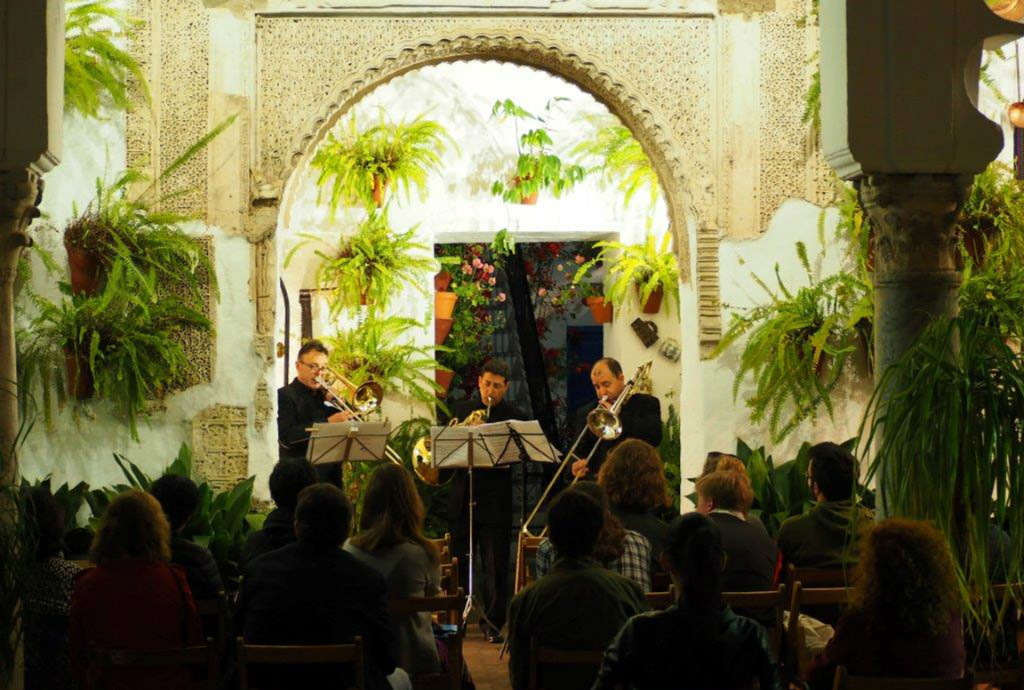
Oil, 8: this house has three patios. First, called Roman courtyard, It has an irregular floor plan and its walls are made of old brick.. A round stone fountain occupies the central area. Also noteworthy are numerous archaeological remains and two beautiful cypress trees. The second is the patio de las Orzas, it has a beautiful roof and an old brick blind arch. The third is the kitchen patio, and has an old stove with pots and pans.
ink, 9: Its elements include a well with a curb located in the wall that separates the gallery and the patio., and next to the entrance arch to the house, the stone basin and an old toilet. Presents a wide variety of plants and pots, but a centennial lemon tree stands out.
Barrionuevo, 43: from the hallway of this house we access two patios separated by a semicircular brick arch. On the right side we find the building, proper, while the left side is a high dividing wall with the adjoining house. The second courtyard, at the bottom, presents a well with a twelfth century curb next to some stairs that lead to the house on the first floor and the roof terrace. Both patios are adorned with beautiful flowers and pots.
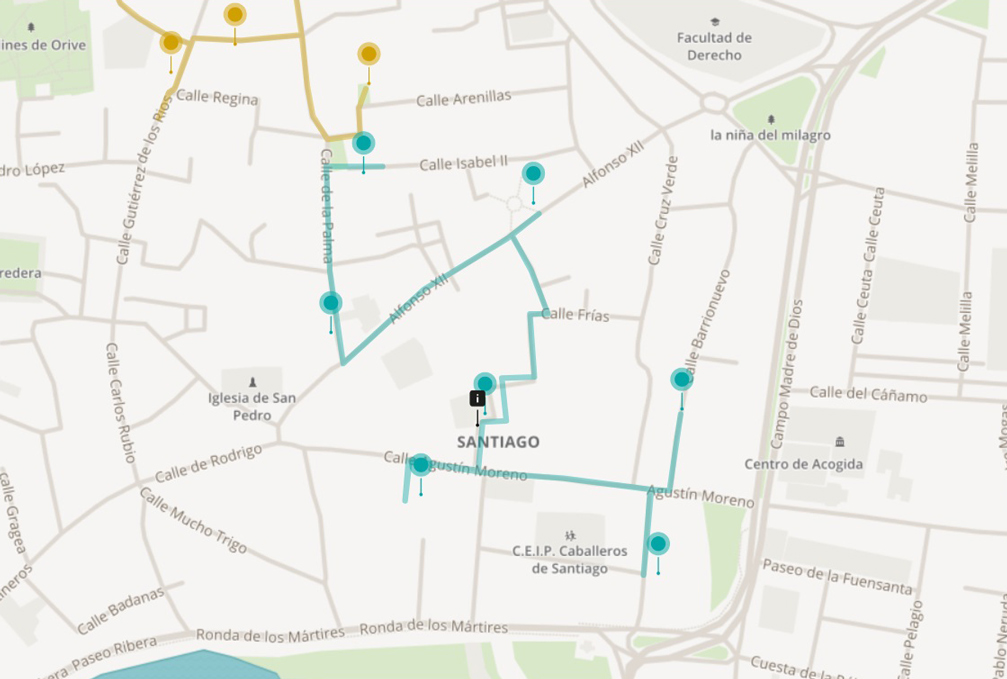
Regina Realejo Route (4)
Cups Square, 11: laundry piles are located in the courtyard of this old tenement house, a well surrounded by vegetation and latrines in the farthest corner. The patio opens with traditional floral species from the Cordovan patios. Exotic bamboo canes grow in a flowerbed.
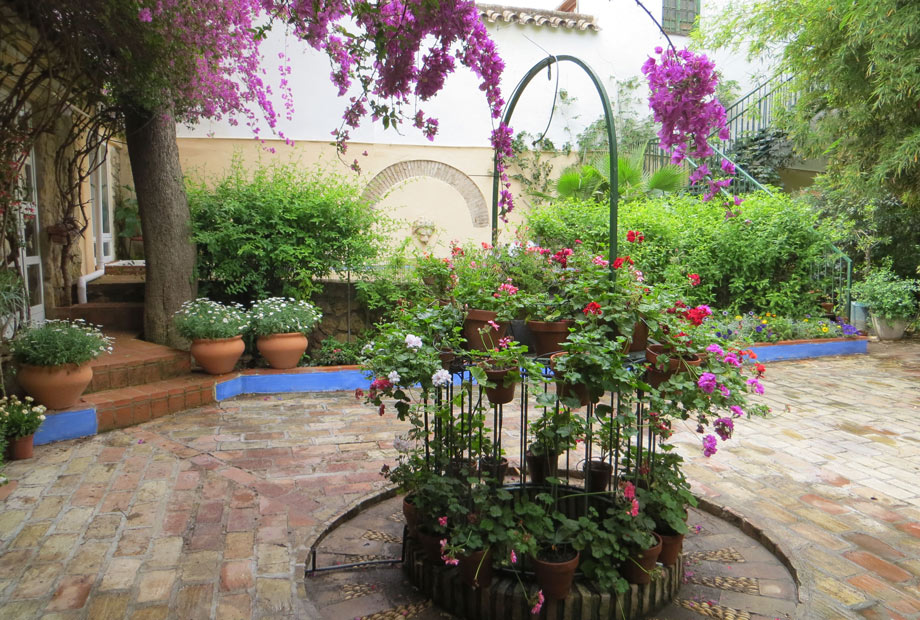
Diego Mendez, 11: this patio presents a structure at two heights, with an upper gallery combining the reddish of yesteryear with the green. Give off charm from your geranium pots, gitanillas, pilistras…
Duke of Victoria, 3: beautiful patio surrounded by four galleries, two main ones with semicircular arches on elegant marble columns and two narrow projections supported by fine wrought iron columns. At the end of the patio, where was the old kitchen, there is another smaller patio. On the ground we can find authentic Moorish brick.
Gutierrez de los Ríos, 33: The patio of this house is very unique as it has a Roman and Arabic structure with a marbled hallway and a Castilian gate.. The ground is at two heights, and the light albero colored walls are decorated with flowerpots and a blind window in the background of which diamonds are drawn in white and blue tiles.
Plaza de Orive, 2: The Orive Palace is a Renaissance building made in the year 1560. This Palace has two patios, around which the rooms are distributed. The first yard that can be found is that of carriages. This Cordovan enchinado patio is small in size, It has a brick arcaded gallery on two of its sides and communicates with the central patio through a loggia. The central courtyard has a quadrangular plan. One of its sides consists of three semicircular arches on the ground floor. Presents an austere image due to the lack of ornament. The other three sides of the courtyard have semicircular arches on Arab and Roman columns. This patio has white walls and a beautiful marbled floor. Regarding the decoration, the circular fountain that occupies the center of the main patio stands out.
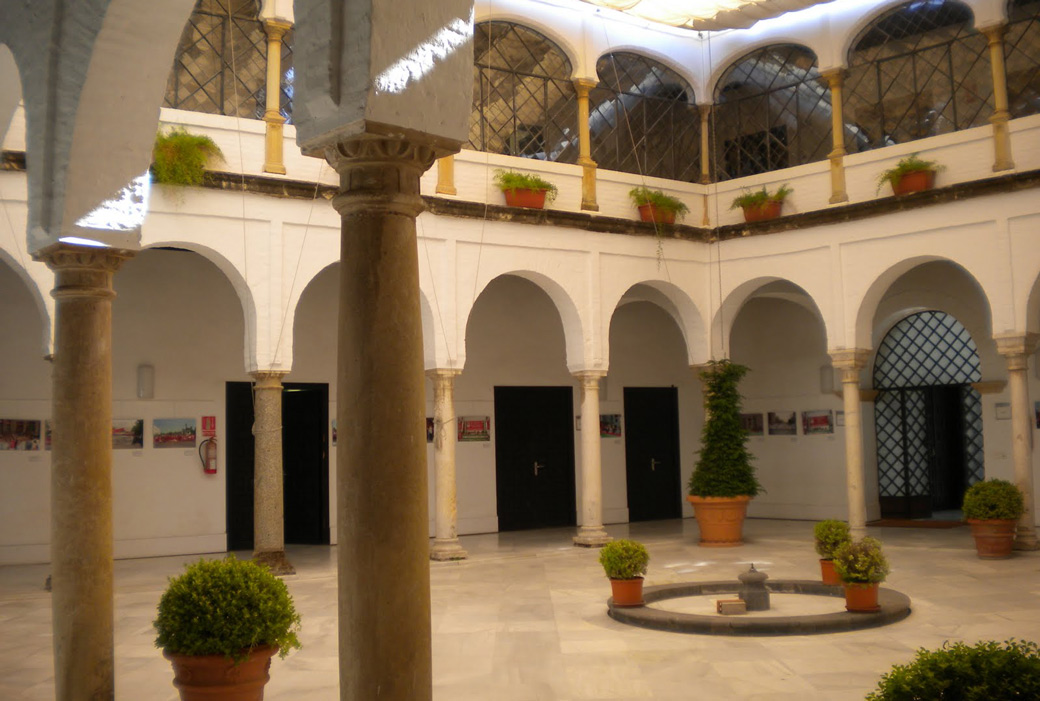
Count of Arenales, 4: This house has its origin in a house from the beginning of the 20th century in which two families lived. This small patio is rehabilitated. The walls have a plinth of typical Granada tiles up to half and the other half is whitewashed. The floor is marble.
Pedro Fernandez, 6: Modern architecture patio with typical Cordovan wood flooring and Sevillian tile plinth. Presents rectangular shape, with two whitewashed semicircular arches on two of its facing walls. It could be an old manor house.
Pedro Verdugo, 8: preserves old wooden beams, iron supports and original structure with two floors. From the hallway with vaulted ceilings you can see the small patio, in which a whitewashed Arab well stands out with its buckets and tin watering cans.
Escañuela, 3: patio that has the characteristic of being a long L-shaped corridor. It presents an elevated space where a fountain and a decorative well are located.
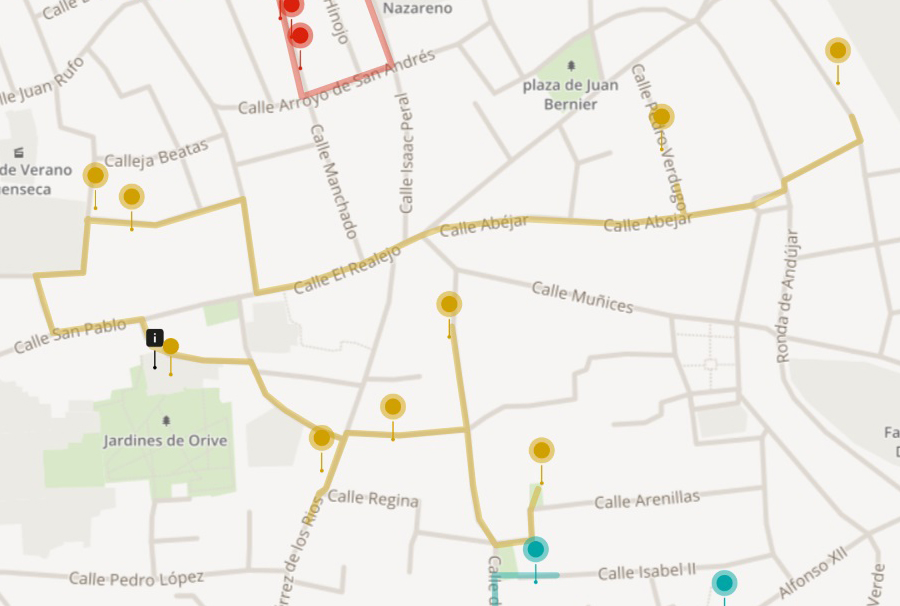
Santa Marina Route – San Agustin (5)
Short, 3: rectangular patio with a modernist arch in the background and a fountain below that refreshes the flowerbed. This patio shows us a very heterogeneous floral variety, from olive tree to various common typical plants such as gypsy, geranium or carnations. A giant poinsettia also adorns this large space.
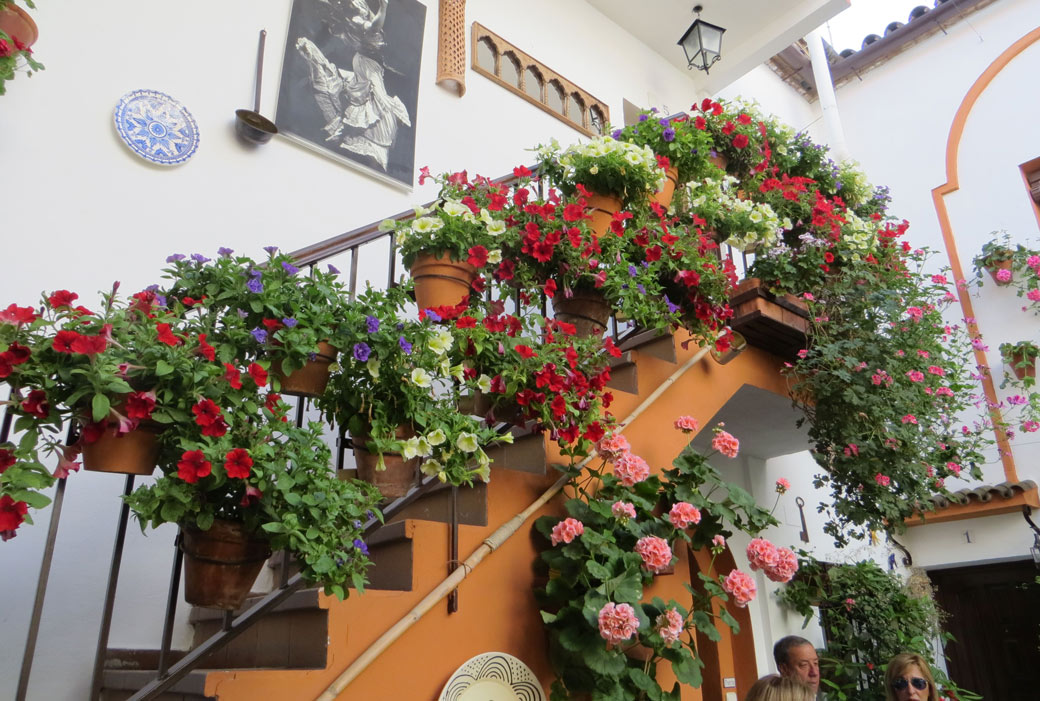
Moroccans, 6: the structure of this patio is very unique, since it has several streets that communicate with each other, exposing the old dependencies of life together: the battery room, the kitchen with all its utensils and well-preserved stove, the toilets with their signs, the wells…
Tafures, 2: small and collected patio, Cordovan Chinese floor with a beautiful central hexagonal fountain of Mozarabic inspiration. On the side it has a lintel porch and columns with bases and capitals from the second half of the 19th century. In it we can also see a great variety of flowers along with various rural decorative pieces.
Zarco, 15: Square courtyard surrounded by artificial stone columns and capitals on which eight exposed brick arches are arranged. The patio paving is fine brick inlaid with blue and white ceramic tiles. In this courtyard, a statue of a seated child stands out from whose lips the water flows that falls into a fountain below it., attached to one of the pillars.
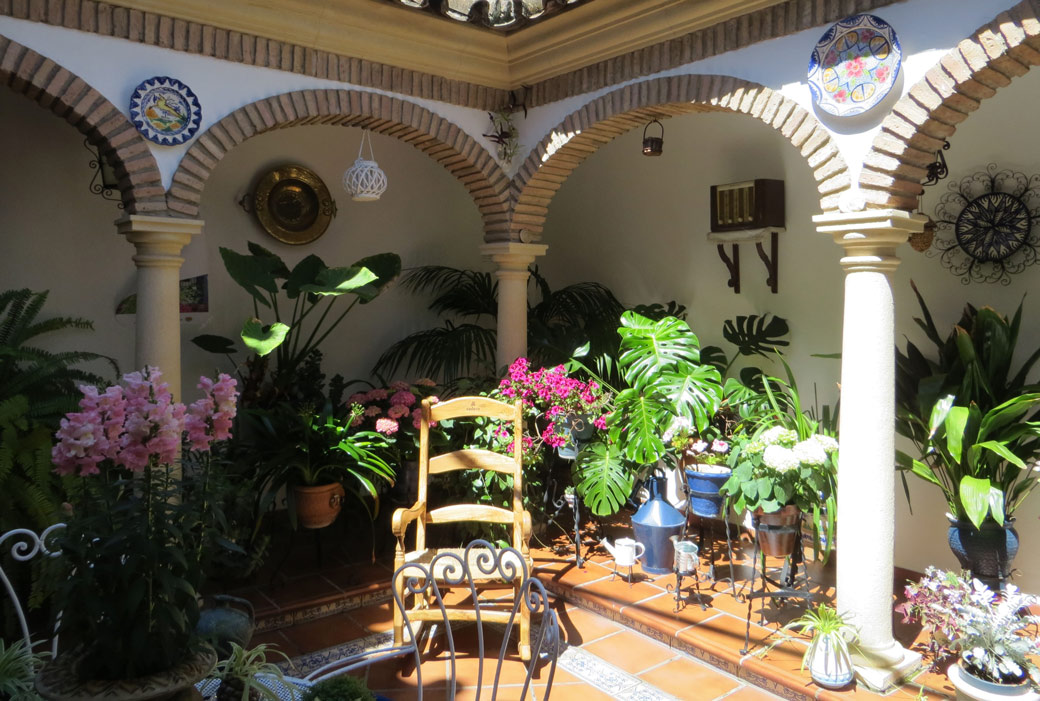
Zarco, 13: in a small square-shaped plot, a bay built around its perimeter forms a small hilly patio as the center of the house.
Ocaña, 19: this Cordovan Chinese courtyard is embellished by the brick pylon of one of its walls. This space shows us a floral variety of great beauty.
Parras, 6: patio that presents two different types of construction. The oldest is formed by a portico of columns with Tuscan capitals and semicircular arches that were bricked up. The later construction presents on the ground floor a gallery of brick pilasters and semicircular arches. The floor of this patio is made of bowls and reveals in the center a well with a wrought iron curb.. We must highlight a large lemon tree on one side of the patio and a beautiful fine asparagus.
Parras, 8: modern architecture courtyard that preserves many ancient elements, such as two 18th century wash basins and a dividing well. This patio is located in a house of more than 400 years of antiguaty. Formed, together with house number six on this same street, part of a convent, later going to be used both as barracks and then hospital. Finally, the property was divided, giving rise to several tenement houses.
Parras, 5: the walls of the ground floor of this patio are decorated with Sevillian tiles. On its pillars there is supported a gallery of columns with striking arches that are repeated over the patio windows.. The patio features a decorative well with a stone curb.
Palace of the Cancela (Viana Palace): in the Palacio de Viana we can enjoy twelve patios and a garden. The Courtyard of the Chapel has a central fountain with two arcaded sides, where we can admire several Roman mosaics. The Patio de la Cancela has in its center a baptismal font that has been transformed into a fountain. Under the Patio del Pozo an underground river runs: in ancient times, a ferris wheel stood in this courtyard. The Patio de los Gatos is a neighborhood courtyard of medieval origin. The Garden is a large green space lined with box hedges, with a labyrinth of corridors that converge in the circular fountain of the same.
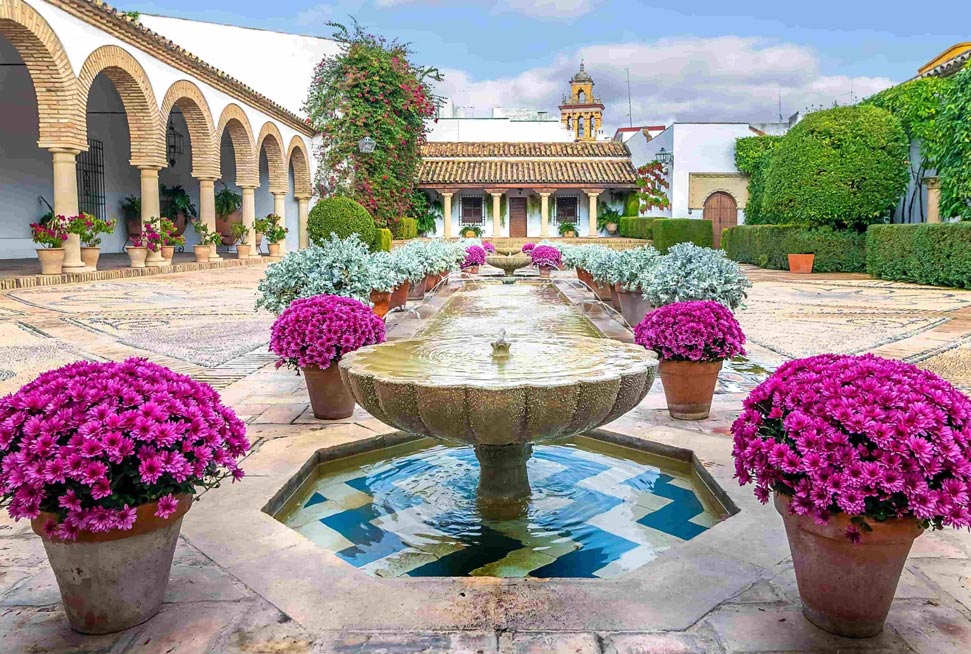
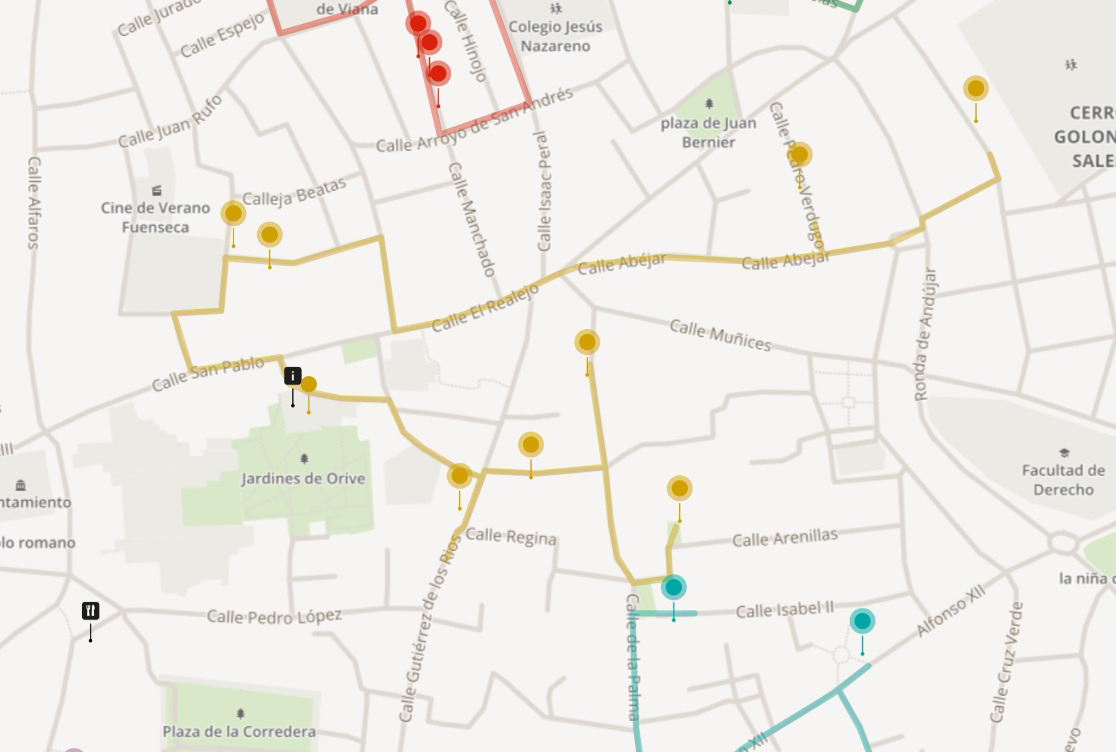
San Lorenzo Route (6)
Shepherdess, 2: patio with a pavement that combines chino and slabs of different sizes and colors, a chapel, a well of Arab origin with a caliphal terracotta curb and some archaeological remains, highlighting a relief of Visigothic origin. Likewise, we see a solid wood door with old iron nails and a water fountain, under which there is a pylon.
Pozanco, 6: old tenement house renovated in recent years. in the backyard, the old Chinese and cement floor has given way to an earthenware pavement and is surrounded by a plinth of Sevillian tiles. The patio stands out for its large number of pots.
Mariano amaya, 4: the patio constitutes the structural nucleus of this house, so there are numerous doors that open in its walls. The two lintel porticoes located at the ends of the patio stand out., that have simple pillars as a support element and a small gallery whose floor is the same as the rest of the room, cobblestone bowling cordovan. The other sides are smooth walls that hang a large number of flower pots. It stands out the presence of an attached well of which the pulley and the metal bucket have been preserved. At the other end there is a winery and a small fountain that has a tank to collect the water..
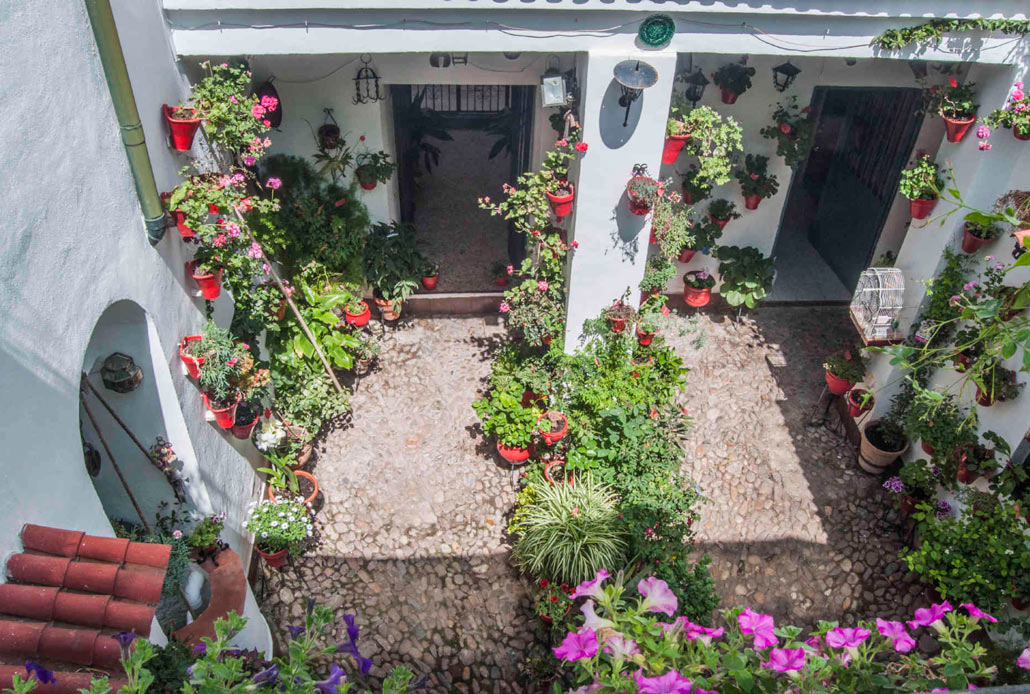
Pozanco, 21: quadrangular courtyard connecting, through a covered walkway, with another elongated patio where the laundry room and other rooms are. This patio features a great variety of flowers: carnations, geranios, gitanillas… but we must highlight a large central industrial drum from which a lemon tree emerges and a decorative well that serves as a planter for a palm tree.
San Rafael Square, 7: courtyards of the Church of the Juramento de San Rafael. In the first courtyard the pavement is the original bowling alley. The tombstone that includes the apparitions of the Archangel San Rafael stands out. Likewise, in a corner there is an effigy of Saint Raphael. The second patio served as a corral and orchard. In it stands out an ornamental font that resembles in its forms a baptismal font. Two metal birds perch on it.
Barter, 4: institutional courtyard known as "Patio de Carmela", which is the typical neighborhood patio around which the houses are distributed. Features white walls with wooden-framed windows and iron bars. It has cordovan wood flooring, except for some areas that are paved with clay slabs. This house is famous for its Arabic-inspired well, still in use, located in the center of the courtyard. Both the curb and the pitchforks are made of masonry and are covered with a gabled roof.. Florally highlights the presence of the lemon tree, next to flowerbeds with a diversity of plants.
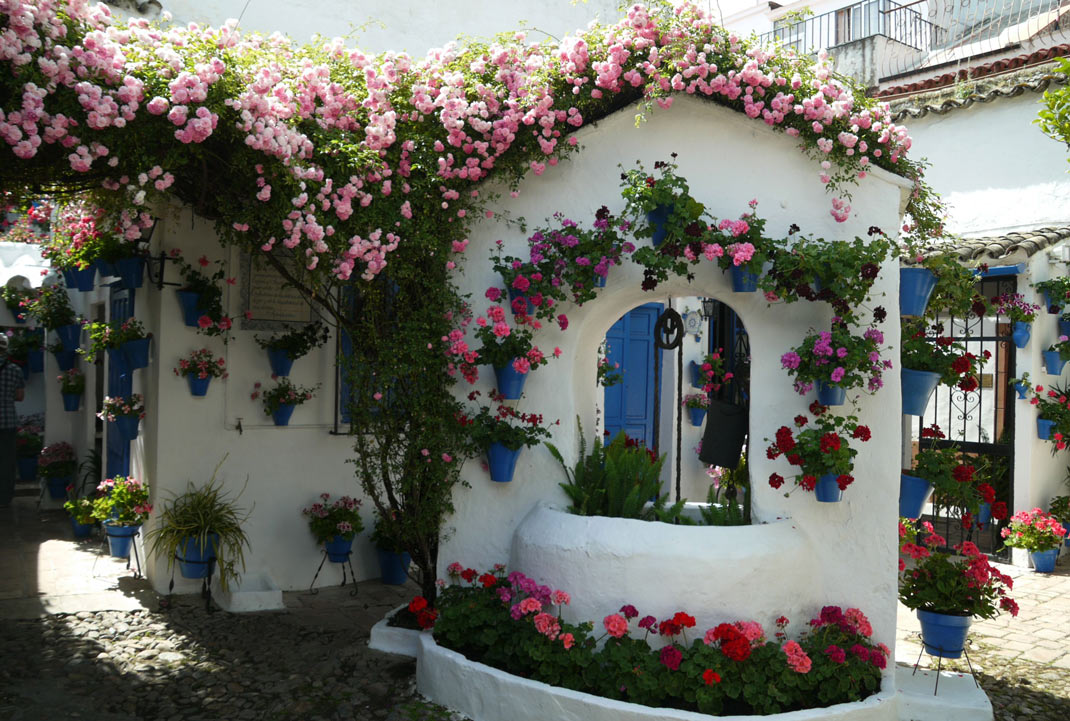
Alvar Rodriguez, 8: modern architecture patio with clay slab paving. All the courtyard walls are blank except one, in which open metal windows with bars decorated with small floral details. In the courtyard there is also a basin that collects the water spilled through a metal spout. Around it there are endless pots with flowers and plants of very different types.
Alvar Rodriguez, 11: patio that has a rectangular shape. The traditional Cordovan enchinado stands out in its soil, a whitewashed well with a gabled roof adorned with an image of Saint Raphael and a fountain attached to one of its sides. On another of its sides we can see a porticoed gallery supported by exposed brick pillars.
Frailes, 6: patio where we find a curb of an Arab well and a Roman column with two semicircular arches of old brick. It also has a stone fountain in one of its corners, and in another a bank, also made of stone. This is a patio where the blue color occupies most of its corners, a fact that gives it a different appearance to the rest of the patios.
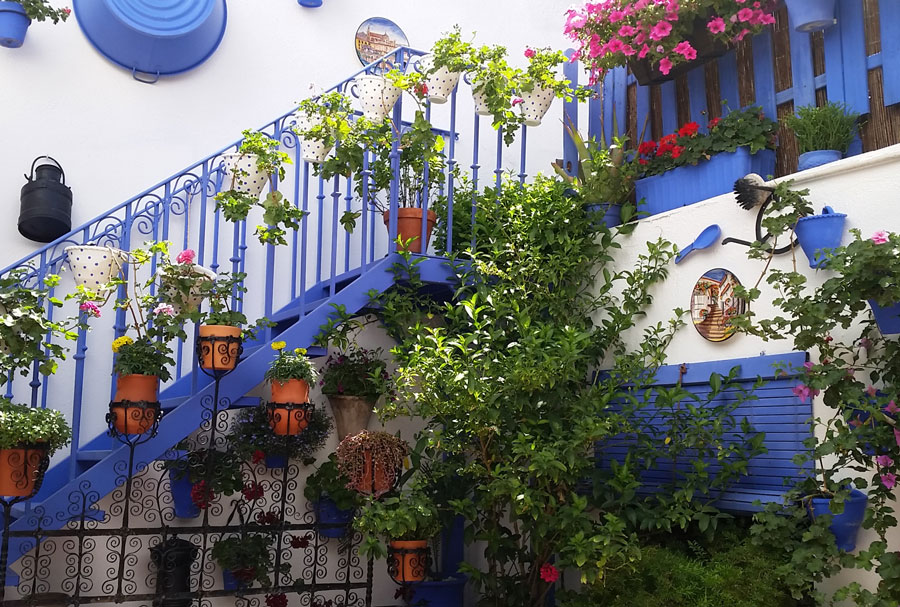
San Juan de Palomares, 8: rectangular shaped patio paved with Cordovan Chinese. In it stands out an old reddish stone basin with a spout, above which there is a stone relief of the Archangel Saint Raphael. What's more, we observe an iron curb of the well from which water is still extracted to water the plants. Archaeological remains of capitals and columns tell part of our history among various plants and ornamental flowers.
San Juan de Palomares, 11: this patio communicates directly with the street. In it there is an old laundry that has a beautiful Arabic font and an old well with a stone curb. Its bowling pavement is typical, very abundant in the streets of the Jewish quarter. In its center stands a huge palm tree, on the trunk of which many flower pots are usually hung, which adorn this old patio with their colors..
Guzmanas, 7: house that most likely dates back to the 15th century. Of the patio, it is worth highlighting its arch and well in Mudejar style, that retains its original curb. At the exit to the patio and in honor of bygone times the kitchen has been recreated, that was located in that place next to the well. Its plants are cared for with great care and thanks to the great luminosity of the patio they remain in bloom almost all year round..
